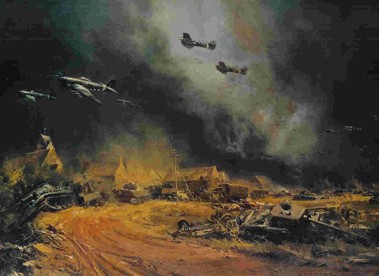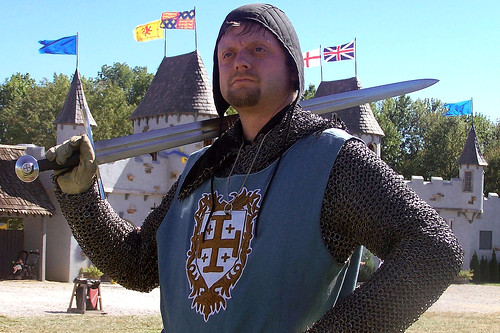“The Army might screw you and your girlfriend might dump you and the enemy might kill you, but the shared commitment to safeguard one another’s lives is un-negotiable and only deepens with time. The willingness to die for another person is a form of love that even religions fail to inspire, and the experience of it changes a person profoundly.”
Sebastian Junger, War
“There are two things a combat deployment offers which all of us strongly desire. The first, being purpose. Every morning we woke up and knew why we were there. It is immediate and unavoidable. Although, it is extreme and unpleasant, there is a comfort in that purpose. The second, is simplicity. We have one goal. There are relatively simple rules on how to accomplish it, and we understand that just about everything will go wrong. Pretty simple.”
Adam Fenner, Post-Deployment Wisdom For Those Expecting A Returning Service MemberThere is as much folklore as science in the accounts of maneuver units that do exceptionally well in close combat. Empirical and anecdotal evidence gathered from combat studies of the Second World War, Korea, and Vietnam has shown conclusively that elite maneuver units, carefully selected and trained, not only perform better in combat but do so with many fewer casualties from all sources of combat incapacitation (for example, from disease and combat fatigue). Such units fight so effectively because they are composed of soldiers of exceptionally quality – better trained and better led as well as coalesced through long-term association that builds familiarity and mutual trust. The difference between carefully trained and led units and those of lesser quality is dramatic.”
Robert H. Scales Jr.

BACKGROUND. What I’m about to say in this piece doesn’t merely reflect my opinion. It is based upon my own experience and observation—together with considerable research and practical field experiments carried out by some military friends of mine. What they found was that if a ground unit works very closely with air—with both constantly exchanging information—then the situational awareness of the battle-space is dramatically enhanced.
What is ‘situational awareness?’ It means—in layman’s terms—that you know what is going on. In a military sense, it means you know where your forces are in detail; you know where the enemies forces are in detail; and, ideally (you should be so lucky) you know the intentions of both sides. You also know the terrain and are familiar with any other factors that may be relevant—such as your supply situation, the weather, the potential for collateral damage and so on. There is a great deal to know in combat, and it changes fast. Nor matter what, you are likely to know less than you need. In combat, you act constantly on the basis of imperfect information. It is profoundly stressful. It wears away at good people—our people.
Ground maneuver supported constantly by air is, of course, far more than CAS (Close Air Support). CAS is primarily a matter of ground calling in air to destroy a target or targets (though there are occasions when air will act unilaterally if friendly positions are known with certainty). It is not quite destruction on demand because CAS—as currently implemented—is only intermittently available, and may take some time to respond after being called. How long is “some time?” Too long if you are under fire.
IGAM (Integrated Ground Air Maneuver)—which is what I am advocating—involves a much closer interdependent relationship. If implemented properly, after a while ground and air can virtually read each other’s minds. Also, current technology means that each can see what the other can see (within limits). The result is serious synergy.
Such combat synergy doesn’t eliminate the confusion that is endemic to combat—but it lessens it—it increases tactical options, and it decreases casualties. You can be bolder and maneuver faster with less risk. These are huge advantages.
WHY DO WE HAVE SEPARATE ARMED SERVICES? We tend to take the existence of our separate armed services—such as the Army, the Navy, the Marine Corps, the Air Force, and the Coast Guard—for granted, but it might be a great deal better if we didn’t. Where the Pentagon is concerned, the amount of effort which goes into inter-service rivalry vastly exceeds the energy we expend fighting our official enemies.
Yes, I know my definition of the services is not technically correct since the Marine Corps is part of the Navy, but it reflects the de facto situation.
THE MICC—MONEY IS THE FOCUS. The reason for that is simple. The military establishment, as currently structured, has ongoing access to truly prodigious riches—the spend on National Security (the DOD budget is only part) totals over a trillion dollars a year in all—so it is predictable, in an incentive based culture, that the primary focus of all concerned will be on how to divide up the spoils.


That glittering pot of gold is irresistible. It demands focus. It downright commands it. The incentives are stacked that way—as is the culture of the MICC (Military Industrial Congressional Complex). The MICC is greed driven, totally obsessed with the money flow (the term widely used)—and largely indifferent to the genuine National Security needs of the country.
You can see clear evidence of this even in wartime, when vast sums are committed to the supposed needs of future wars—whereas the immediate requirements of the current shooting war go un-met. Self -interest doesn’t give way to the public good just because there is a war on.
True, there tends to be much courage and selflessness displayed at the sharp end by the fighting troops—who deserve all the support they receive, and more—but as far as the MICC is concerned, war is both an irritation and a distraction from those big ticket projects that come in late, and over budget, after decades of ever rising costs (like the F-35)—and a profit opportunity (which they tend to seize with alacrity). Selflessness is not a characteristic of the MICC.
WAR WITHOUT END. A further factor is that this bureaucratic war is a war without end—whereas shooting wars tend to be of limited duration (though that may change). Accordingly, the permanent tends to receive more attention than the temporary.
ARMY FIEFDOMS. This segmentation extends into the services themselves. The Army, for instance, is divided by branches such as Armor, Aviation, Infantry, and so on. Airborne is a qualification—not a branch (though it acts like a branch). Such branches tend to end up as fiefdoms—each with a baron (general) in charge.

IS COMBAT EFFECTIVENESS HINDERED? The issue which has long preoccupied me is whether segmentation—whether by service or by branch—inhibits combat effectiveness. I understand both the practical and emotional reasons for such divisions (belonging to a particular branch enhances your sense of loyalty and self-esteem, for instance—and specialization makes things easier to organize—but I have come to the conclusion that it does inhibit combat effectiveness (and seriously at that).
A unit is most effective in combat if all its resources are combined in one orchestrated effort (each element contributing as, and when, required). That sounds like no more than common sense, but it’s much more difficult to achieve than you might think. For instance, I witnessed one attack at Fort Irwin in the Mojave Desert where the commander just plain forget about his artillery—so didn’t use it. True story.
But, it’s much more complicated than that. Different units have a tendency to move at different speeds for a host of reasons—from command style to type of vehicle to terrain. They see the battle-space from different perspectives. Visibility is frequently inadequate. Different types of firepower can interfere with each other (if you use your artillery and your attack helicopters at the same time—without careful coordination—you make find them—the projectiles in the case of the artillery—occupying the same piece of sky). And then you have an enemy with his own agenda who is quite determined to destroy yours (and you). And you haven’t slept for god knows how long!
Training doesn’t eliminate confusion. Combat defines confusion. What it does do is improve the ability of all concerned to cope with it. For obvious reasons, training is most effective when all your combat resources train together. This happens much less often than you might think—particularly where different services are involved. One reason is cost—another reason is laziness or inertia—but mindset is no small factor. If there isn’t a full understanding of the advantages of integrating ground and air, why would anyone want to train that way? And, unbelievably, so far, there isn’t. The Army is conservative. People stay—and train—in their lanes.
ARMY VERSUS AIR FORCE. NEGLECT OF CAS. The great inter-service problem today is the split between the Army and the Air Force. The Air Force used to be part of the Army, but became a separate service in 1947. The separation was bitter to a degree that is hard to understand. In fact, Lieutenant General Quesada was called a traitor by Air Force colleagues for closely cooperating with the Army after D-Day towards the end of WW II—and, since that time, the Air Force has had a tendency to neglect CAS (Close Air Support). Instead it has focused on air supremacy, interdiction, strategic bombing, and space—together with logistics.
By and large, it has done an excellent job in these areas (though you can debate its procurement policies—and the F-35 in particular) but its handling of CAS has been mediocre and grudging, at best. Fundamentally—and this seem to be built into the Air Force culture—it doesn’t seem to want the CAS mission. In fact, a good example of this is its current determination to retire the A-10, a purpose-built CAS aircraft of high survivability and proven effectiveness. But the Air Force also came in for strong criticism for not doing enough to support the Army in Afghanistan—and from the Secretary of Defense at that.
The Army has reacted to the Air Force’s neglect of CAS by developing Army Aviation—which is primarily based upon helicopters (though it has a fixed wing component as well). It formally became a branch in 1983.
The Army’s Apache AH-64 Longbow helicopters are ferociously effective, but are more vulnerable to ground fire (as was shown in 2003 near Karbala, Iraq, where some 30 aircraft were hit—out of close to 40—and one brought down) than the Air Force’s fixed wing aircraft. This is because the Apache flies much lower and slower than the Air Force’s machines. On the other hand, Apache crews—equipped with excellent day/night sensor and vision equipment—see more, and are much more closely informed about the detail of the ground combat. Unfortunately, their fuel consumption is such that their loiter time in the battle-space is limited—and their relatively low speed can mean they take longer than is desirable to get to where the ground force needs support.
Why doesn’t the Apache utilize air-to air-refueling? It’s tricky with a helicopter because of the rotor, but it is possible. I suspect it’s because the Army has no aerial tankers of its own.

It also much be said that although much has been written about the vulnerability of the attack helicopter, in practice they have proven to be much more survivable in combat than has been projected—despite the fairly widespread availability of MANPADS (Man Portable Air Defense systems). This survivability has a great deal to do with the tactics used as well as the defensive tools employed. It tends to demand particularly well-trained crews—and it speaks well of them.
The neglect of the CAS mission by the Air Force has always been a serious issue. However, recently it has become an even greater cause for concern for these reasons:
- PRECISION GUIDED MUNITIONS. The development of PGMs (Precision Guided Munitions such as JDAM bombs) now means that the Air Force can bomb with unprecedented accuracy. A consequence of that—assuming you have air supremacy and enough aircraft—is that an associated ground force can be virtually unbeatable and, therefore, can be smaller than has been traditional.
- SURVEILLANCE. Surveillance technology has improved quite dramatically. This means that aircraft can now study the battlespace effectively from a relatively safe height. They can’t see stuff that has been concealed—but they can normally identify what they can see with considerable accuracy.
- DRONES. Armed drones have added a whole new air capability.
BOTTOM LINE. The bottom line here is absolutely clear. Ground and air capabilities (though not necessarily all air capabilities) need to be integrated within a unified command structure. It no longer makes sense for a ground unit to operate, within a hostile environment, without air cover at all times. In effect, that means that ground and air should train together—which in turn really means they should belong to the same unit.
It’s worth while thinking through the implications of integrating ground and air. It’s a combination that very few military powers would be able to withstand.
But why have ground forces at all?
Combat experience to date shows that although air power can do a great deal, a creative enemy can still conceal considerable strength on the ground—without being detected—regardless of the most sophisticated sensors and surveillance equipment.
The techniques used to avoid detection are both high tech and low tech, but the end result is that if you want to defeat an enemy, you tend to need ground troops as well. They can search in the kind of hands-on way required. This is particularly the case in urban areas—where great care has to be taken to avoid collateral damage. In short, there are decided limits to what you can do from the air. We can severely restrict mobility—and do more than ever before—but it is still not enough to be reliably decisive. A weak enemy will give in. A committed enemy will fight on.
When it comes to holding ground—which is what you tend to want to do after you have seized it—then ground troops are needed for that aspect as well. Experience has shown that even where you make ground into a free-fire zone, you cannot hold—and thus utilize—terrain from the air.
What determines ‘holding ground?’ Physical possession. Denying its use to an enemy. Being able to utilize it to one’s own advantage. Sometimes it is very far from clear. Being physically present on land you cannot utilize is a debatable advantage—and common
Despite waste and greed—arguably endemic to the human condition—there is no doubt that the U.S. has evolved an extraordinarily powerful military machine—by far and away the most powerful in the world. However, its track record in the sort of messy, asymetric wars we seem to specialize in, is decidedly mixed. We have no problem dealing with conventional forces, but considerable difficulties dealing with guerillas.
Such irregular forces don’t wear uniforms so are hard to distinguish from the regular population. They don’t adhere to the rules of war—such as they are—and yet tend to have access to portable but powerful weaponry. Perhaps most serious of all, they seem to be able to either make, or otherwise lay their hands on, powerful explosives. Given our tendency to be road bound and predictable—and be dependent on long logistic tails—we are exceedingly vulnerable to such people unless, and until, we change the way we operate.
It is my belief that if we integrated ground and air as discussed we could both cut our costs and be more effective militarily. If the former is a naïve assumption given that the MICC is so strong—and integrated into the very fabric of National Security—then perhaps we will have to settle for increased military effectiveness.
That would be no small thing in itself.

Where consistent integrated ground/air is concerned, ideally you need a survivable aircraft armed with a gun and PGMs, which has a long loiter time, is equipped for surveillance, and is relatively inexpensive to deploy. The F-35, with which the Air Force proposes to replace the A-10 with, does not meet those criteria. The A-1o isn’t perfect either—there is some room for improvement here—but it would still be the superior choice. Soldiers love it.
TELLING ISIS NO GROUND TROOPS! Regarding President Obama’s statement that he won’t employ U.S. ground forces to fight ISIS directly, I regard that as a serious error of judgment.
- You should never tell an enemy what you are going to do—or not to do. Being unpredictable is fundamental.
- I don’t think he understands what could be achieved with ground/air integration—and I’m not sure most generals do either.
UNDERLYING FACTORS.
- The Fog of War is a reality. That means that you need to be prepared to deal with all contingencies which requires that you should never exclude any particular lawful capability—because you may need it in a hurry (and probably will).
- The U.S. approach to war at present is depressingly predictable. We need to be prepared to do the absolutely unexpected at speed—such as landing a force in Syria to take out both ISIS and Assad. I’m not seriously proposing this—though it has a decided appeal—but, in this case, it is an example.
- We are not devoting nearly enough thought to achieving psychological dominance—to obtain the kind of leverage you get from conquering an enemy through speed and surprise. For a recent example of that, you need to look no further than ISIS’s recent successes in Iraq. These victories have given them an awesome reputation out of all proportion to their actual strength—and have significantly increased their image so recruits are flocking to them. Success breeds success. Meanwhile, once again we are being slow, methodical. and predictable. We have the resources to be vastly more creative—and to shake our enemies to the very core. Either we lack the imagination—or we have chosen not to.

No comments:
Post a Comment